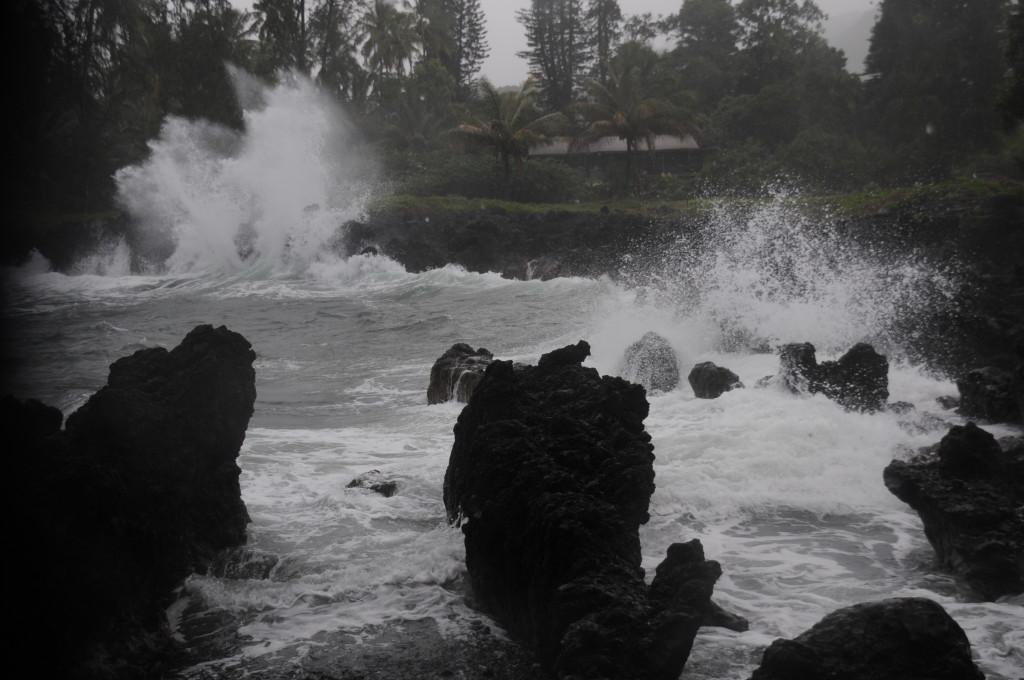Maui stories: Road to Hana review
Once visitors enter the Hana highway, they are immediately engulfed in nature’s beauty. Coined the “Road to Hana,” this particular route proves to be a popular tourist attraction, even in heavy rain. But what is so unique about a highway to some small town?
The scenic drive says it all. Within a few minutes on the highway, visitors witness the lush vegetation throughout Maui’s terrains. The setting is undeniably a paradise. Looming trees, verdant bushes, and dramatic rivers inhabit such rich soils that even arborists may have trouble identifying.
To those unlucky visitors beginning the road trip accompanied by rain, be prepared for a long, wet day. According to adventuremaui.com, since Hana is located on the eastern coastline of Maui, rain is frequent and lasts for long periods. Though it is vital to sustain the vegetation, the rain is not always welcomed with open hands. While the mild drizzles may initially cause minor setbacks, they transform into giant pours in a flash. The heavy rain may hinder some visitors from stepping out of the car and exploring Maui’s natural beauty.
In addition to the pouring rain, the low speed limit in the serpentine roads impedes racecar drivers from reaching Hana within two hours. The route initially commences with merely a few turns here and there, but the further along the drive, the windier and narrower the path becomes. It all leads to a point where turns recurrently occur every few seconds, accumulating into what seems like hundreds, even thousands of them.
Despite the setbacks, food stands selling snacks such as banana bread, shave ice, and fruit are conveniently located at certain points along the route for a quick bite.
A small shack sporting a large colorful “Halfway to Hana” sign sells food and beverages to sustain visitors for the second leg of the road trip. As the proud home of “‘The Original’ Banana Bread,” the rest stop provides awnings hovered over picnic tables for visitors to relax and enjoy their snacks. The banana bread enhances people’s impression of the journey; it is sold in small six-dollar loaves and has a sweet, savory taste with the occasional banana chunk.
In addition to the snack, the Road to Hana is most known for its numerous Kodak moments—whether that be of the verdant surroundings or of the breathtaking waterfalls formed by the natural alcoves in the mountain.
One of the popular sightseeing destinations is Keanae Peninsula. With massive, rugged rocks along the coastline, the waves viciously crash into the shore on a rainy day, a sight many would consider too violent in comparison to that of Maui’s many beaches. For photographers, though, the peninsula is a paradise: waves surge over 50 feet into the air while trees sway with the wind—the suburban scenery seems as though it has been untouched for the past decade.
Driver or rider, visitors will be worn out before the escapades have concluded, or even be overcome with lassitude by the road halfway to Hana. At first, the lush environment may be a pleasant adventure; however, the seemingly endless road drags on with nearly identical surroundings—trees, bushes, rocks.
With each lengthy mile, the verdure becomes bland and mundane, eventually boring passengers and leaving them longing for the end. And, for passengers easily prone to carsickness, skipping this trip is highly advised.
Aside from that, the route should be added to the list of attractions for first time visitors to Maui. The surreal habitat and natural wonders of the environment captivate visitors, leaving them with an unforgettable trip. The Road to Hana is certainly the way to go.

Mercedes Chien is the design editor for The Winged Post. This is her fourth year in the program and previous positions she's held include Photography and...

A member of the journalism program since freshman year, senior Allison Sun is the Features Editor and Webmaster of Harker Aquila. She was also TalonWP...


















![“[Building nerf blasters] became this outlet of creativity for me that hasn't been matched by anything else. The process [of] making a build complete to your desire is such a painstakingly difficult process, but I've had to learn from [the skills needed from] soldering to proper painting. There's so many different options for everything, if you think about it, it exists. The best part is [that] if it doesn't exist, you can build it yourself," Ishaan Parate said.](https://harkeraquila.com/wp-content/uploads/2022/08/DSC_8149-900x604.jpg)




![“When I came into high school, I was ready to be a follower. But DECA was a game changer for me. It helped me overcome my fear of public speaking, and it's played such a major role in who I've become today. To be able to successfully lead a chapter of 150 students, an officer team and be one of the upperclassmen I once really admired is something I'm [really] proud of,” Anvitha Tummala ('21) said.](https://harkeraquila.com/wp-content/uploads/2021/07/Screen-Shot-2021-07-25-at-9.50.05-AM-900x594.png)







![“I think getting up in the morning and having a sense of purpose [is exciting]. I think without a certain amount of drive, life is kind of obsolete and mundane, and I think having that every single day is what makes each day unique and kind of makes life exciting,” Neymika Jain (12) said.](https://harkeraquila.com/wp-content/uploads/2017/06/Screen-Shot-2017-06-03-at-4.54.16-PM.png)








![“My slogan is ‘slow feet, don’t eat, and I’m hungry.’ You need to run fast to get where you are–you aren't going to get those championships if you aren't fast,” Angel Cervantes (12) said. “I want to do well in school on my tests and in track and win championships for my team. I live by that, [and] I can do that anywhere: in the classroom or on the field.”](https://harkeraquila.com/wp-content/uploads/2018/06/DSC5146-900x601.jpg)
![“[Volleyball has] taught me how to fall correctly, and another thing it taught is that you don’t have to be the best at something to be good at it. If you just hit the ball in a smart way, then it still scores points and you’re good at it. You could be a background player and still make a much bigger impact on the team than you would think,” Anya Gert (’20) said.](https://harkeraquila.com/wp-content/uploads/2020/06/AnnaGert_JinTuan_HoHPhotoEdited-600x900.jpeg)

![“I'm not nearly there yet, but [my confidence has] definitely been getting better since I was pretty shy and timid coming into Harker my freshman year. I know that there's a lot of people that are really confident in what they do, and I really admire them. Everyone's so driven and that has really pushed me to kind of try to find my own place in high school and be more confident,” Alyssa Huang (’20) said.](https://harkeraquila.com/wp-content/uploads/2020/06/AlyssaHuang_EmilyChen_HoHPhoto-900x749.jpeg)



